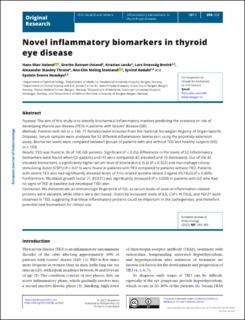| dc.contributor.author | Ueland, Hans Olav | |
| dc.contributor.author | Ueland, Grethe Åstrøm | |
| dc.contributor.author | Løvås, Kristian | |
| dc.contributor.author | Breivik, Lars Ertesvåg | |
| dc.contributor.author | Thrane, Alexander Stanley | |
| dc.contributor.author | Stokland, Ann-Elin Meling | |
| dc.contributor.author | Rødahl, Eyvind | |
| dc.contributor.author | Husebye, Eystein Sverre | |
| dc.date.accessioned | 2023-01-18T10:42:59Z | |
| dc.date.available | 2023-01-18T10:42:59Z | |
| dc.date.created | 2022-10-24T08:43:25Z | |
| dc.date.issued | 2022 | |
| dc.identifier.issn | 0804-4643 | |
| dc.identifier.uri | https://hdl.handle.net/11250/3044242 | |
| dc.description.abstract | Purpose: The aim of this study is to identify biochemical inflammatory markers predicting the presence or risk of developing thyroid eye disease (TED) in patients with Graves' disease (GD).
Methods: Patients with GD (n = 100, 77 females) were included from the National Norwegian Registry of Organ-Specific Diseases. Serum samples were analysed for 92 different inflammatory biomarkers using the proximity extension assay. Biomarker levels were compared between groups of patients with and without TED and healthy subjects (HS) (n = 120).
Results: TED was found in 36 of 100 GD patients. Significant (P < 0.05) differences in the levels of 52 inflammatory biomarkers were found when GD patients and HS were compared (42 elevated and 10 decreased). Out of the 42 elevated biomarkers, a significantly higher serum level of interleukin-6 (IL6) (P = 0.022) and macrophage colony-stimulating factor (CSF1) (P = 0.015) were found in patients with TED compared to patients without TED. Patients with severe TED also had significantly elevated levels of Fms-related tyrosine kinase 3 ligand (FLT3LG) (P = 0.009). Furthermore, fibroblast growth factor 21 (FGF21) was significantly increased (P = 0.008) in patients with GD who had no signs of TED at baseline but developed TED later.
Conclusion: We demonstrate an immunologic fingerprint of GD, as serum levels of several inflammation-related proteins were elevated, while others were decreased. Distinctly increased levels of IL6, CSF1, FLT3LG, and FGF21 were observed in TED, suggesting that these inflammatory proteins could be important in the pathogenesis, and therefore potential new biomarkers for clinical use. | en_US |
| dc.language.iso | eng | en_US |
| dc.publisher | Oxford University Press | en_US |
| dc.rights | Navngivelse 4.0 Internasjonal | * |
| dc.rights.uri | http://creativecommons.org/licenses/by/4.0/deed.no | * |
| dc.title | Novel inflammatory biomarkers in thyroid eye disease | en_US |
| dc.type | Journal article | en_US |
| dc.type | Peer reviewed | en_US |
| dc.description.version | publishedVersion | en_US |
| dc.rights.holder | Copyright 2022 the authors | en_US |
| cristin.ispublished | true | |
| cristin.fulltext | original | |
| cristin.qualitycode | 2 | |
| dc.identifier.doi | 10.1530/EJE-22-0247 | |
| dc.identifier.cristin | 2064123 | |
| dc.source.journal | European Journal of Endocrinology (EJE) | en_US |
| dc.source.pagenumber | 293-300 | en_US |
| dc.identifier.citation | European Journal of Endocrinology (EJE). 2022, 187 (2), 293-300. | en_US |
| dc.source.volume | 187 | en_US |
| dc.source.issue | 2 | en_US |

